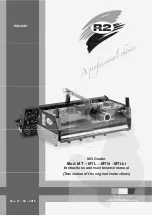
9
IMPORTANT!
Spilled fuel is a leading cause of hydrocarbon emissions. Some states may require the use of automatic fuel shut-off
containers to reduce fuel spillage.
After use
• DO NOT store a unit with fuel in its tank. Leaks can occur. Return unused fuel to an approved fuel storage container.
Storage -
Fuel storage laws vary by locality. Contact your local government for the laws affecting your area. As a precau-
tion, store fuel in an approved, airtight container. Store in a well-ventilated, unoccupied building, away from sparks and
flames.
IMPORTANT!
Stored fuel may separate. ALWAYS shake fuel container thoroughly before each use.
1.
Place the unit on a flat, level
surface.
2. Clear any dirt or other debris from
around the fuel filler cap.
Filling the Fuel Tank
CAUTION!
Slowly remove the fuel cap only
after stopping the engine
.
WARNING!
Minimize the Risk of Fire
■
NEVER
smoke or light fires near
the engine.
■
ALWAYS
stop the engine and
allow it to cool before refueling.
■
ALWAYS
Wipe all spilled fuel and
move at least 3 meters (10 feet)
from the fueling point and source
before starting.
■
NEVER
place flammable material
close to the engine muffler.
■
NEVER
operate the engine
without the muffler and spark
arrester screen in place and in
good working condition.
■
FUEL IS HIGHLY FLAMMABLE.
■
ALWAYS
store gasoline in
a container approved for
flammable liquids.
■
ALWAYS
inspect the unit for
fuel leaks before each use.
During each refill, check that
no fuel leaks from around
the fuel cap and/or fuel tank.
If fuel leaks are evident, stop
using the unit immediately.
Fuel leaks must be repaired
before using the unit.
■
ALWAYS
move the unit
at least 3 meters (10 feet)
away from a fuel storage
area or other readily flam
-
mable materials before
starting
the engine
.
3.
Remove the fuel cap, and fill the
tank with clean, fresh fuel.
4.
Reinstall the fuel filler cap and
tighten firmly.
5. Wipe away any spilled fuel before
starting engine.










































